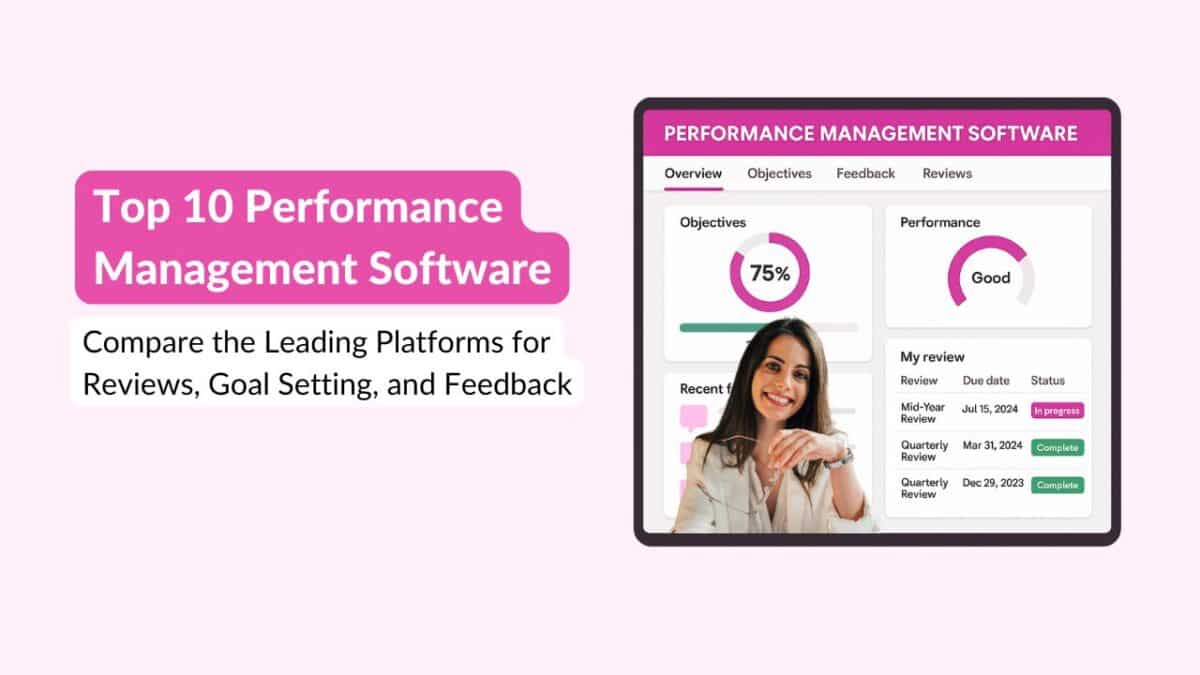“The Global Human Capital Trends report by Deloitte highlighted that 49% of executives found their Performance Management Process to be ineffective and required a complete overhaul.” The statistics highlight why choosing the right employee performance management software has become essential for organizations aiming for consistent, measurable outcomes.
In the last two years, organizations have remodeled their business processes to contain the impact of the pandemic and thereby boost the productivity of their employees working remotely and from the office. This shift has amplified the need for reliable employee performance management software that can support hybrid work environments.
However, regarding performance management, the achievement is not significant. A survey conducted by Kronos found that 95% of HR leaders feel that employee burnout is sabotaging their workforce retention. The problem calls for robust employee performance management software that can support continuous evaluation, real-time insights, and structured reviews.
By utilizing performance review software, organizations can ensure that their review process is structured, efficient, and focused on measurable outcomes, ultimately leading to better employee performance and engagement.
This article will help you understand how modern employee performance management software operates, the intricacies of performance management systems, and explore the various features of the top 20 performance management software. We will unpack the following in the sections below:
- What is a Performance Management Software?
- Importance of Performance Management Software
- Features of Performance Management Software
- Top Performance Management Software
What Is Employee Performance Software in 2026?
Employee performance software in 2026 goes far beyond basic review systems—it’s a real-time, AI-powered platform that tracks outcomes, enables continuous feedback, and supports strategic development. It includes features like:
- Live performance dashboards
- Two-way feedback loops and recognition tools
- Predictive analytics for talent insights
- Seamless integration with communication channels and HR ecosystems
Today’s software powers ongoing performance dialogue and development, not just annual checkboxes.
Why Employee Performance Software Matters Today
- Data + Trust Gaps: Deloitte reports that 72% of employees distrust current performance management systems.
- Engagement & Outcomes: Continuous systems help managers coach in real time—boosting alignment and performance.
- AI Adoption & Demand: Companies like Paycom saw a rise in demand after adding AI-driven task automation and at-risk employee alerts.
- Human-Centered Trends: Beyond metrics, 2026 emphasizes feedback that’s meaningful, emotionally intelligent, and growth-oriented.
TL;DR – Top 20 Performance Management Software (2026 Guide)
- Engagedly – AI-powered, all-in-one performance & talent management platform
- Lattice – Unified platform for performance, engagement, and development
- 15Five – Focuses on manager effectiveness and continuous feedback
- Leapsome – Integrates OKRs, feedback, surveys, and learning in one suite
- Reflektive – Real-time feedback and engagement analytics
- PerformYard – Customizable review cycles with deep reporting
- Deel – Global HR platform with integrated performance management
- HROne – Goal-driven OKRs and performance insights
- Betterworks – OKRs + coaching integrated into a modern HCM
- 7Geese/Paycor – AI-powered OKRs & performance inside Slack/Teams
- Peoplebox.ai – AI-driven performance, feedback, and engagement
- Workleap – 360° feedback + AI analytics for SMBs
- Thrivesparrow – Performance + hiring + workforce planning
- ClearCompany – Flexible 360 feedback and performance reviews
- Primalogik – Simple, continuous feedback & review cycles
- Small Improvements – HRIS with customizable review and feedback tools
- Workable HR – Native Microsoft Teams performance management
- Teamflect – AI-first 360° feedback in minutes
- Effy.AI – Comprehensive OKR platform with performance integration
- Profit.co – India-focused HRMS with built-in performance and appraisal tools
What is Performance Management Software?
Performance management is a tool used by organizations globally to increase employee productivity and help them become successful in their job roles. Today’s employee performance management software is designed to simplify this entire process through automation, analytics, and structured feedback tools. The process encompasses continuous communication between a manager and employees for the mutual achievement of organizational goals.
Changing business needs and the latest technological developments have given rise to new-age performance management software that helps in holistic workforce management. The traditional practice of annual performance review is now transitioning into continuous process management.
The latest developments in performance management involve setting clear objectives and goals, task assignments, frequent check-ins, providing feedback at regular intervals, and analyzing the results. Through this, managers and leaders can track the performance of their employees and provide them feedback in real-time to help them perform better at their jobs.
Performance management helps organizations utilize the complete potential of their employees and provides effective measures to increase employee engagement, collaboration, and retention. Through the analytics feature offered by the tools, executives can look into the intricacies of performance management and create an actionable plan for performance improvement.
Importance of Employee Performance Management Software
The primary aim of business performance management is to align leaders, managers, team members, and resources to meet the strategic goals of the business. By providing metrics to measure the performance and productivity of the system, leaders can gauge the early signs of a potential threat and create workarounds to get the business on track.
Continuous Performance Management (also known as Agile Performance Management) helps in creating a productive and skilled workforce by analyzing the performance gaps and offering solutions to increase productivity through training and mentoring.
Performance management tools are becoming increasingly important for organizations to be successful in the current business environment. By adopting employee performance management software, leaders can understand what’s working, close performance gaps, and make data-backed decisions.
Employee performance management software can be highly beneficial to organizations. The following points highlight its importance in the workplace.
Also Read: How continuous performance management can help improve productivity?
Boost Employee Engagement and Productivity
(Globally, 85% of employees are disengaged or not actively engaged at work, resulting in massive loss of business and revenue- A report by Gallup). Employee engagement and productivity are directly linked to the success of an organization. Engaged employees are involved actively in their work and can create strong bonds with their colleagues.
By utilizing continuous performance management, organizations can create an environment of trust, support, and encouragement. Using employee performance management software helps streamline this process by connecting goals, feedback, and progress tracking in one place. Strategic implementation of a performance management solution helps in aligning the individual goals with the organizational goals.
Employee Reskilling and Upskilling
A LinkedIn 2021 workplace learning report shows that 94% of employees would have stayed longer at their last organization had the company invested in their learning and development. The report also highlighted that the interest and zeal to learn is highest among the younger workers belonging to Gen Z.
Providing mentoring and coaching to employees not only helps them perform better at their jobs but also motivates them to take up more responsibilities. By reskilling and upskilling employees, organizations can attract new talent and train existing employees to take up managerial positions.
Employee development is at the heart of business performance management solutions, and organizations can reap numerous benefits by using them effectively.
Improves Workplace Communication and Collaboration
A report by McKinsey highlights the importance of communication in the workplace. It states that improved communication can increase the productivity of interacting employees by 20-25%. Another report by CMSWIRE states that 85% of employees use more than one device for communication.
The statistics outline the importance of clear and efficient workplace communication. The major difference between a performing and a non-performing team is efficient communication. By improving communication in the workplace, organizations can improve employee efficiency and mitigate critical risks that lead to the failure of the organization.
Top 20 Performance Management Systems in 2026
The successful implementation of software can cause a ripple effect in the organization. It helps in aligning the workforce towards the business goals and makes employee engagement and collaboration easier.
As many organizations are paving their way to digitizing and modernizing their performance systems, the following list of employee performance management software will be helpful to them in selecting the right tool that matches their organizational needs and objectives.
- Engagedly
- Lattice
- 15Five
- Leapsome
- Reflektive
- PerformYard
- Deel
- HROne
- Betterworks
- 7Geese/Paycor
- Peoplebox.ai
- Workleap
- Thrivesparrow
- ClearCompany
- Primalogik
- Small Improvements
- Workable HR
- Teamflect
- Effy.AI
- Profit.co
1. Engagedly
Engagedly is an AI-powered talent management platform designed to help organizations build high-performing, people-first cultures. At the heart of Engagedly is Marissa AI, an Agentic AI layer that automates repetitive HR tasks, delivers real-time insights, and empowers HR leaders, managers, and employees to focus on strategic, impactful work.
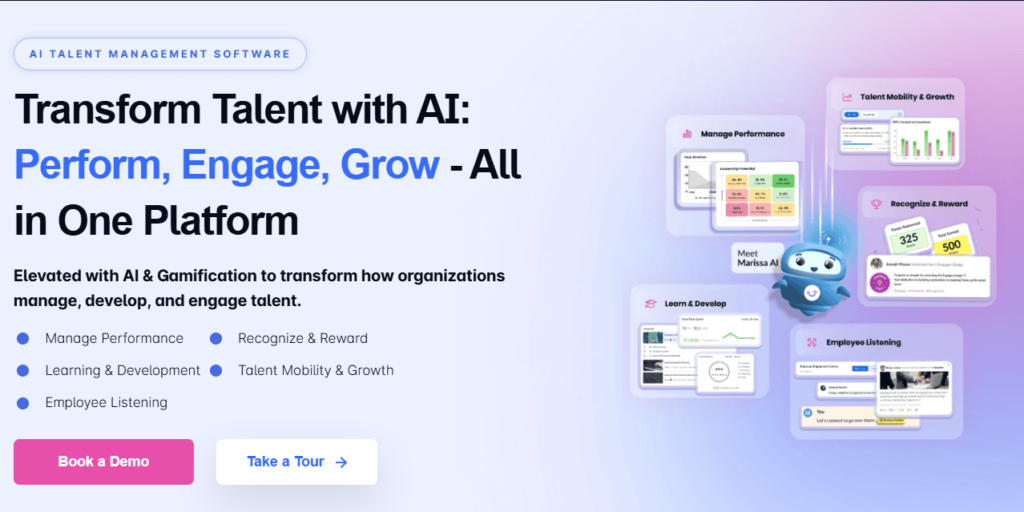
Built around the E3 framework—Engage, Enable, Execute, Engagedly seamlessly blends performance management, employee engagement, development, and recognition into one unified platform. From OKRs and 360-degree feedback to skill development and cultural alignment, every feature is designed to drive measurable outcomes.
What Sets Engagedly Apart:
- Agentic AI Capabilities: Role-based AI agents handle tasks like onboarding, feedback nudges, learning recommendations, meeting summaries, and engagement analysis—freeing up teams for high-value work.
- Scalable & User-Friendly: Intuitive for both employees and HR teams, and adaptable across organizations of all sizes.
- Proven Impact: Companies using Engagedly have seen 2.5× faster goal alignment, 60% reduction in review cycle time, and over 30% improvement in employee development plan completions.
Key Solutions Offered:
- OKR & performance management consulting
- Performance reviews & 360 feedback
- OKR alignment, goal setting & tracking
- Continuous 1:1 check-ins & project reviews
- Leadership development & succession planning
- Employee engagement surveys & analytics
- Personalized learning & skill-building paths
- Onboarding workflows
- DEI & cultural alignment initiatives
- AI-driven talent insights & recommendations
2. Lattice

Lattice provides engaging features for enterprises and supports employee growth and development. The software uses intelligent methodologies to combine performance management, employee engagement, and employee development into one holistic solution.
Solutions offered by lattice:
- Goal Management & OKRs: Set, track, and align organizational, team, and individual goals with OKR frameworks, ensuring visibility across the company.
- Performance Reviews: Conduct structured annual, quarterly, or project-based reviews with customizable templates and rating scales.
- 360-Degree Feedback: Facilitate peer, manager, and self-assessments to provide well-rounded performance insights.
- Real-Time Feedback: Allow employees and managers to give and receive instant recognition or constructive feedback.
- Engagement Surveys & Pulse Checks: Measure employee sentiment with customizable surveys and AI-driven analytics.
- Employee Growth Plans: Create personalized career development plans tied to skills, competencies, and organizational needs.
3. 15Five

15Five is a tech-powered platform that offers employee engagement, continuous performance management, and manager effectiveness. The solution combines software, education, and community to build effective managers and improve employee performance.
Solutions offered by 15Five:
- Weekly Check-Ins – Simple surveys that keep managers informed about employee progress, challenges, and morale.
- Continuous Feedback – Real-time feedback tools that encourage timely recognition and constructive input.
- OKR & Goal Tracking – Aligns individual and team objectives with organizational goals, with progress tracking dashboards.
- Engagement Surveys – Science-backed surveys to measure employee engagement and identify improvement areas.
- 1-on-1 Meeting Agendas – Structured templates and scheduling tools to make manager-employee conversations more productive.
- Performance Reviews – Streamlined review cycles with customizable forms, rating scales, and automated reminders.
4. Leapsome

This software provides a continuous cycle of performance management and personalized learning through features like OKR management, performance reviews, employee engagement surveys, feedback, and praise. It helps in aligning the workforce towards organizational goals.
Solutions offered by leapsome:
- Performance Reviews & 360° Feedback – Fully customizable review cycles, competency frameworks, and role-based feedback to ensure fair and actionable evaluations.
- Goals & OKRs Tracking – Set, align, and monitor organizational, team, and individual goals, with visual progress dashboards to keep everyone on track.
- Continuous Feedback – Real-time recognition and constructive input between peers, managers, and direct reports to build a feedback-rich culture.
- Employee Engagement Surveys – Customizable pulse surveys with analytics to measure engagement drivers and address problem areas proactively.
- Learning & Development Modules – Personalized learning paths, skill frameworks, and integration with external learning content.
- Competency Frameworks – Define skills and expectations for each role to guide employee development and performance measurement.
5. Reflektive

Reflektive is a comprehensive performance evaluation software that assists in business growth through continuous improvement. The tool helps increase productivity through constructive employee engagement and driving growth through high-performance-driven teams.
Solutions offered by Reflektive:
- Real-time Feedback
- Easy and quick employee recognition
- Multiple user tagging
- Performance and talent calibration
- Increase and measure employee engagement through surveys
6. PerformYard

PerformYard is a scalable performance management platform that provides intelligent insights about the workforce through data-driven features. It helps in executing performance reviews, frequent check-ins, real-time feedback, and inputs from throughout the organization.
Solutions offered by Performyard:
- Customizable Performance Review Cycles – Create review schedules that fit your business rhythm, from quarterly check-ins to annual appraisals.
- 360-Degree Feedback – Gather multi-source feedback from peers, managers, and direct reports for a balanced employee performance view.
- Goal Setting and Tracking – Align individual and team goals with organizational objectives, track progress visually, and adjust in real time.
- Continuous Feedback Loops – Encourage frequent, informal feedback to build a culture of ongoing improvement rather than one-time evaluations.
- Automated Reminders and Notifications – Keep managers and employees on track with built-in alerts for upcoming tasks and review deadlines.
- Detailed Performance Analytics – Access dashboards and reporting tools to spot trends, identify high performers, and address skill gaps.
Also Read: How to build performance management metric strategy?
7. Deel
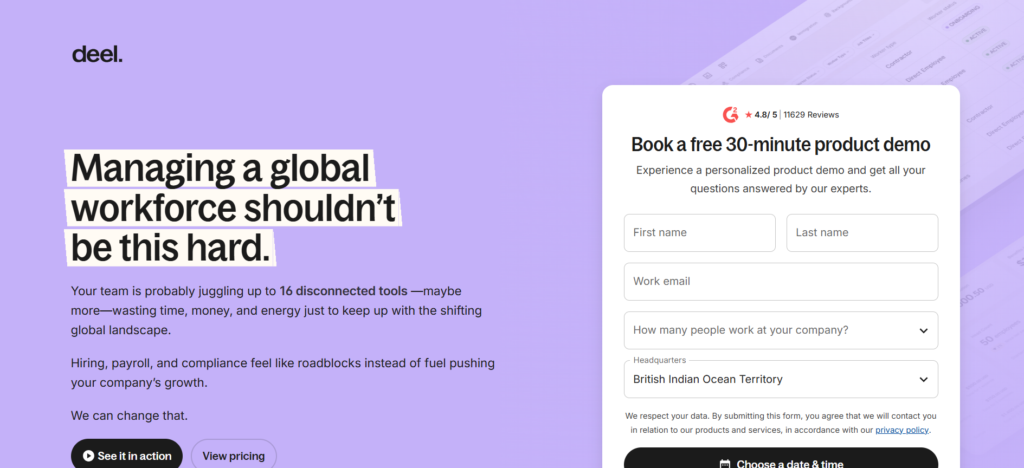
Deel is a global HR platform that combines payroll, compliance, and talent management into one comprehensive solution. While originally known for its employer of record (EOR) services, Deel Engage has evolved into a robust performance management system designed for distributed and international teams.
Solutions offered by Deel:
- 360-Degree Feedback & Reviews – Conduct comprehensive performance evaluations with customizable anonymity settings, peer selection criteria, and multi-source feedback from managers, peers, and direct reports.
- Goal Setting & OKR Management – Create, track, and align individual and team goals with organizational objectives. Use AI-driven suggestions tailored to role, level, and past performance.
- Competency Frameworks & Skills Mapping – Define role-specific competencies and create transparent career progression pathways. Use skills matrices and 9-box grids to identify high potentials and skill gaps.
- Performance Calibration – Compare and calibrate ratings across employee demographics with heatmaps, radar charts, and calibration tools to ensure fairness and reduce bias.
- Automated Review Cycles – Trigger performance evaluations automatically based on probation periods, start dates, or custom criteria. Send personalized auto-nudges and reminders throughout the review process.
- Compensation Integration – Link performance outcomes directly with compensation data to reward top performers and make fair, equitable pay decisions seamlessly.
What sets Deel apart:
Deel’s unique advantage lies in its ability to manage the entire employee lifecycle for global teams—from compliant hiring and payroll in 150+ countries to performance reviews and development plans—all on one platform. This makes it ideal for companies with international workforces who need integrated compliance, payroll, and performance management.
Best for: Global companies and remote-first organizations needing integrated EOR, payroll, and performance management.
8. HROne
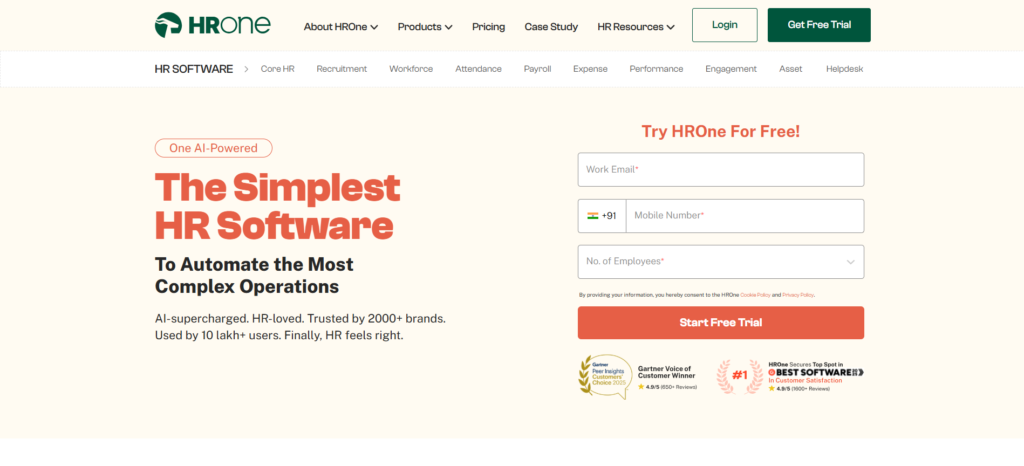
HROne is an AI-powered performance management system, designed for organizations to manage their talent force with data-driven insights and actions. With features like defining and quantifying KPIs, easy performance review process, performance scorecard, 9-box rating, and 1-on-1 meetings for conflict resolution, you can address talent management from all aspects rather than monitoring it superficially.
With its continuous 360–degree feedback feature, you can nurture the skills and performance of your workforce from all touchpoints. For example, you cannot only ask a manager’s feedback for an employee but also from their peers, colleagues, and overall, 8-12 people to get a broader picture of their performance and cultural fit.
Key Solutions Offered:
- Review rating formula for final performance rating
- Easy OKR mapping
- 360-degree feedback process for anonymous and overall feedback
- Easy goal creation and defining of KPIs
- 9-box rating for identifying future leaders
- 1-on-1 for candid manager and person conversation
9. Betterworks

Betterworks helps enterprises scale up their performance by providing intuitive and directional insights. This performance management tool helps create a vision with the right set of goals, reviews, and continuous feedback from the employees. Managers can use features like reviews and check-ins, goal management, and continuous feedback for performance enhancement.
Solutions offered by Betterworks:
- Continuous Performance Management & Check-Ins
- Offers ongoing feedback loops, regular one-on-one check-ins, and light, coaching-oriented performance conversations instead of infrequent formal reviews.
- OKR & Strategic Goal Setting Alignment
- Facilitates company-wide objectives (OKRs) cascaded down to team and individual levels, ensuring alignment of efforts with larger business goals.
- 360-Degree Feedback & Peer Recognition
- Incorporates multi-source feedback, real-time peer-to-peer recognition (e.g., digital badges), and fosters a supportive, transparent feedback culture.
- Advanced Analytics & Reporting
- Equipped with real-time dashboards, trend and historical performance tracking, customizable analytics, and manager-specific insights to guide decision-making.
10. 7Geese/Paycor
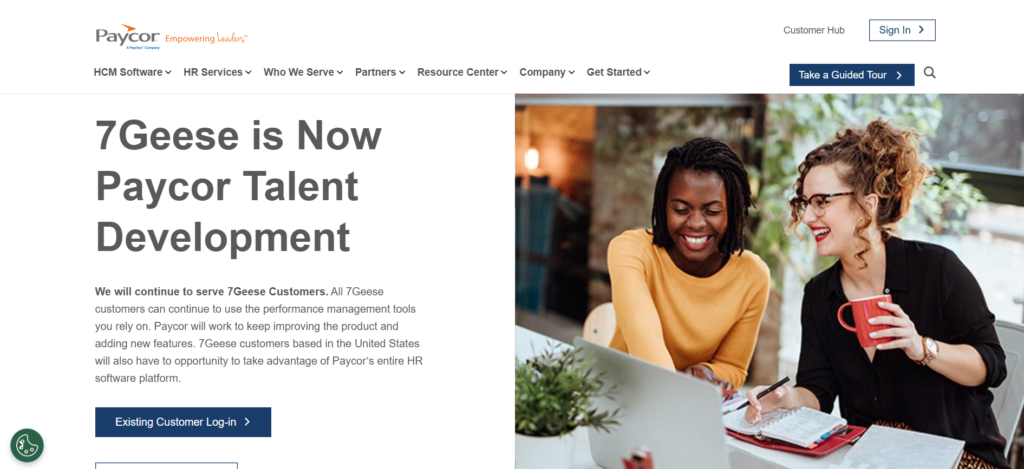
It is a human capital management tool that offers a range of services, like HR & payroll management, talent management, workforce management, and employee experience. It helps in building an engaging and collaborative culture to enhance organizational performance.
Solutions offered by 7Geese/Paycor
- 1:1 and feedback tools
- Automated workflows to eliminate repetitive tasks
- Customizable dashboard for coaching sessions
- OKRs and goal management
10. Peoplebox.ai
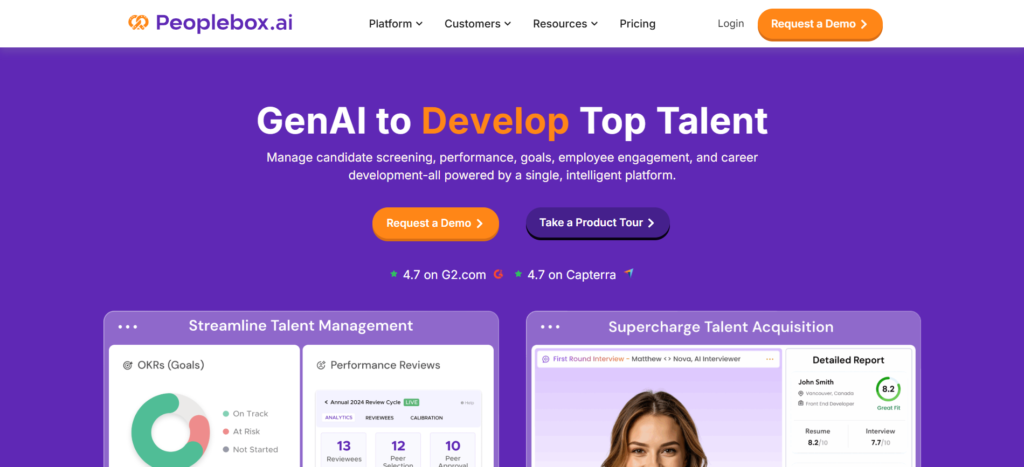
Peoplebox.ai is an AI-powered talent management platform that seamlessly integrates performance management, OKRs, and employee engagement directly into tools teams already use—specifically Slack and Microsoft Teams. The platform emphasizes ease of use, automation, and real-time insights.
Solutions offered by Peoplebox.ai:
- OKR & Goal Management – Set, align, and track objectives and key results across individual, team, and company levels. Auto-update progress through integrations with Jira, Asana, Salesforce, HubSpot, and other work tools.
- Customizable Performance Reviews – Design review cycles tailored to your business needs with flexible templates, rating scales, competency mapping, and goal selection. Run 360° reviews, peer reviews, self-evaluations, and manager assessments.
- 1-on-1 Meetings & Check-ins – Schedule and structure meaningful conversations between managers and direct reports with automated agendas, goal tracking, and action items.
- 9-Box Talent Matrix – Visualize employee performance and potential to identify high performers, succession candidates, and development needs across departments and roles.
- 360-Degree Feedback – Collect comprehensive feedback from multiple sources to provide balanced, unbiased performance insights.
- Engagement Surveys & Pulse Checks – Measure employee satisfaction and engagement through customizable surveys delivered directly in Slack or Teams.
- Business Reviews & Analytics – Conduct strategic reviews where OKRs are set, tracked, and embedded in review boards. Generate detailed reports and analytics to make data-driven talent decisions.
What sets Peoplebox.ai apart:
The platform lives inside Slack and Microsoft Teams, eliminating the need for employees to learn or log into another system. This “no new login” approach drives exceptionally high adoption rates and makes performance management feel like a natural part of daily work rather than an administrative burden.
Best for: Tech companies and fast-growing startups that prioritize Slack or Microsoft Teams and want OKRs, reviews, and engagement in one integrated platform.
12. Workleap

Workleap (formerly Officevibe) is a modular, people-first employee experience platform that brings together engagement, performance management, onboarding, learning, and organizational clarity. Built with AI at its core, Workleap helps organizations—especially SMBs and hybrid teams—simplify HR processes while keeping employees engaged and aligned.
Solutions offered by Workleap:
- AI-Powered Performance Reviews – Build customizable review cycles with self, peer, and manager feedback. Workleap AI generates performance summaries, highlights achievements and growth opportunities, and suggests draft responses to reduce manager workload.
- Goals & OKRs – Create, track, and update individual and team objectives with flexible goal structures. AI analyzes progress, feedback, and context across roles and teams to deliver clear performance synthesis.
- 360-Degree Feedback – Conduct multi-source evaluations with customizable anonymity settings and reviewer groups to match your culture.
- Real-Time Dashboards & Analytics – Monitor review progress, track rating distributions, and compare results across teams with visual dashboards and calibration tools.
- Continuous Feedback & Recognition – Enable ongoing feedback loops with “Good Vibes” peer-to-peer recognition and instant feedback features.
- Engagement Surveys (Officevibe) – Run automated pulse surveys with anonymous feedback, eNPS tracking, and AI-powered sentiment analysis to measure team morale and identify improvement areas.
- Onboarding Workflows – Create personalized welcome portals with role-specific checklists, automated document signing, and progress tracking.
- Learning & Development – Deliver self-paced learning paths with AI-powered course recommendations.
What sets Workleap apart:
Workleap’s Performance Flywheel creates a connected system where goals, reviews, and feedback work together continuously rather than in isolation. The AI Cycle Builder can set up review cycles in minutes, and the platform integrates seamlessly with Slack, Microsoft Teams, and major HRIS systems—all with transparent pricing and no setup fees.
Best for: SMBs, hybrid teams, and remote-first organizations seeking an intuitive, modular platform for performance, engagement, and development.
13. Thrivesparrow
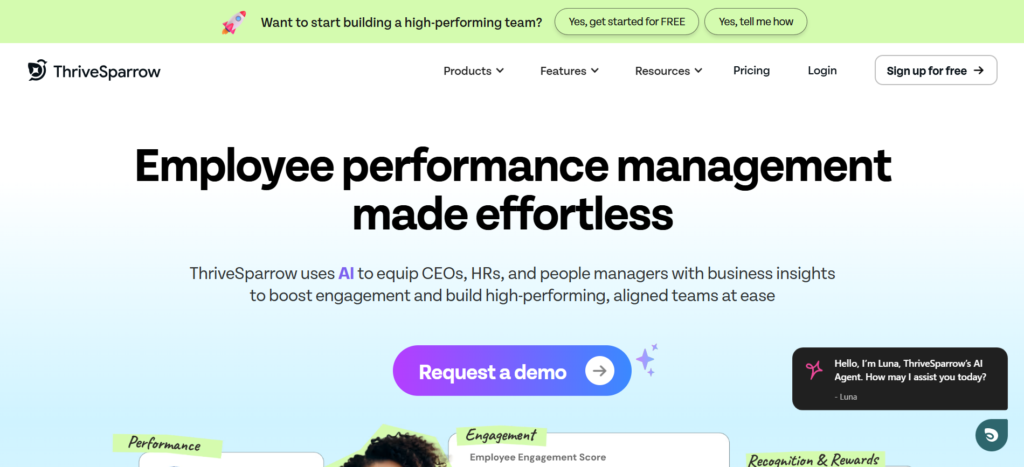
Thrivesparrow is an emerging AI-powered performance management and employee engagement platform designed for small to medium-sized businesses. It combines 360-degree feedback, goal tracking, recognition, and pulse surveys with advanced AI analytics to turn performance data into actionable insights.
Solutions offered by Thrivesparrow:
- 360-Degree Performance Reviews – Collect comprehensive feedback from peers, managers, and direct reports with customizable review cycles, competency frameworks, and role-based evaluations.
- AI-Driven Insights & Analytics – Transform review and survey data into visual heatmaps, bell curves, competency summaries, and trend reports. AI sentiment analysis highlights strengths, skill gaps, and engagement risks.
- Goals & OKRs Tracking – Align individual and team objectives with organizational priorities. Track progress transparently with visual dashboards and real-time updates.
- Continuous Feedback & Recognition – Share instant peer-to-peer feedback and recognition badges to build a culture of continuous improvement and appreciation.
- Engagement Surveys & Pulse Checks – Measure employee sentiment with customizable, multilingual surveys. AI-powered reports provide quick, detailed analysis of results.
- AI-Generated Personal Development Plans (PDPs) – Automatically create personalized development plans based on 360 feedback, GAP analysis, and performance trends—saving managers significant time.
- Rewards & Recognition – Gamified recognition system with point-based rewards and a global rewards marketplace supporting 80+ countries.
What sets Thrivesparrow apart:
Thrivesparrow’s AI capabilities go beyond basic reporting—the platform uncovers what truly drives team performance and provides heat-map visualizations showing performance patterns. The tool is particularly strong in helping managers turn feedback into action with AI-suggested next steps and personalized development plans.
Best for: Small businesses and startups looking for an affordable, feature-rich performance management solution with strong AI analytics capabilities.
14. ClearCompany
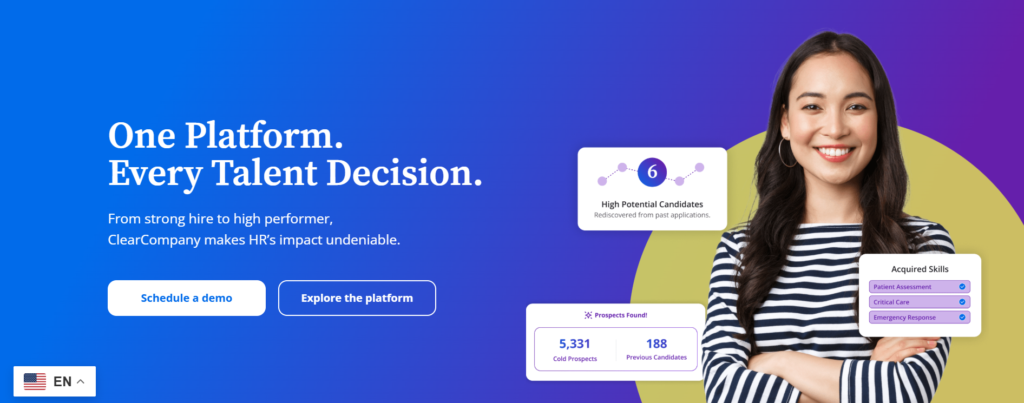
ClearCompany offers a platform that combines recruitment, onboarding, performance management, and workforce planning into one ambit. It offers a range of solutions that help organizations develop and nurture talent for higher performance.
Solutions offered by ClearCompany:
- Workforce planning and analytics
- Employee onboarding
- Employee engagement tools and surveys
- Performance management system
15. Primalogik
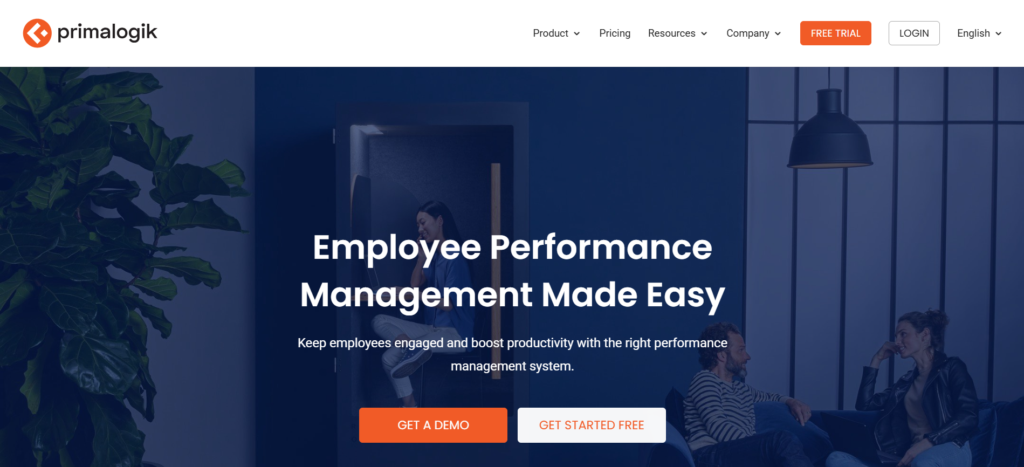
Primalogik is an intuitive, flexible performance management platform specializing in 360-degree feedback, performance reviews, and goal management. Built for mid-sized organizations, it offers extensive customization options while maintaining simplicity and ease of use.
Solutions offered by Primalogik:
- 360-Degree Feedback – Create fully customizable 360 review processes with flexible questionnaires, rating scales (3-point to 10-point), and anonymity levels. Collect multi-source feedback from managers, peers, direct reports, and other stakeholders.
- Performance Reviews – Conduct structured reviews with self-assessments and manager evaluations. Use customizable templates and automated reminders to streamline the process.
- Goal Setting & OKR Management – Set clear, measurable objectives and track progress toward both individual and organizational goals. Managers can collaborate with employees on goal-setting.
- Continuous Feedback & Recognition – Enable real-time feedback exchange and instant recognition throughout the year to build a feedback-rich culture.
- Employee Engagement Surveys – Launch anonymous surveys to gather honest feedback on engagement, satisfaction, and organizational culture.
- Advanced Analytics & Reporting – Access dynamic, easy-to-understand reports that filter through performance data. Compare results over time to track growth and create development plans.
- Development Planning – Build targeted development plans for each team member based on 360 feedback results. Focus on improvement areas and measure progress across review cycles.
What sets Primalogik apart:
Primalogik’s strength is its flexibility—users can build completely custom questionnaires, choose rating scales, and select anonymity levels to match their culture. The platform strikes a balance between powerful customization and user-friendly simplicity, making it accessible even for non-technical users. Customer support is frequently praised as responsive and helpful.
Best for: Mid-sized organizations seeking a flexible, customizable 360 feedback and performance review solution with excellent support.
16. Small Improvements
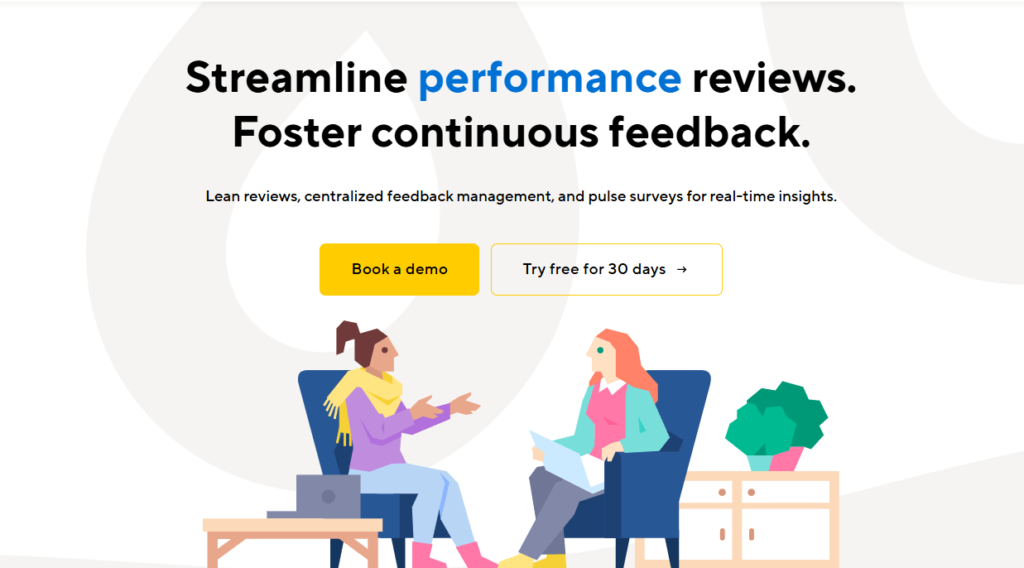
Small Improvements is a lightweight performance management platform built for growing teams. Used by companies like Duolingo, SoundCloud, and Zapier, it helps foster a culture of continuous feedback, alignment, and development.
Key Features:
- Customizable performance reviews & 360° feedback
- Lightweight goals & objectives
- Real-time feedback & praise
- 1:1 meeting agendas & notes
- Pulse surveys & engagement insights
- Integrations with tools like BambooHR, Slack, and Google
Ideal for companies with 10–1350 employees, Small Improvements offers a flexible, user-friendly toolkit to improve performance and employee experience.
17. Workable HR
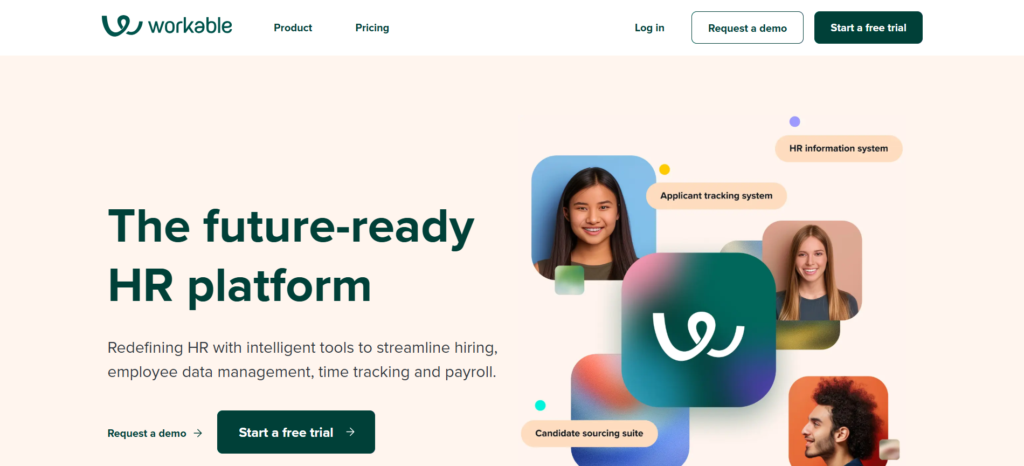
Workable HR is a comprehensive human resources information system (HRIS) that combines recruiting, onboarding, employee management, and performance reviews into one unified platform. While best known for its applicant tracking system (ATS), Workable has evolved into a full-featured HR solution.
Solutions offered by Workable HR:
- Performance Reviews – Create tailored review templates with configurable question types for different roles and departments. Customize review cycles (quarterly, annual, or project-based) to align with company objectives.
- Multi-Level Feedback System – Conduct self-reviews, manager evaluations, peer feedback, and direct report reviews to get a complete 360-degree performance picture.
- Progress Tracking & Reporting – Monitor review completion across the organization with dashboards filtered by department, manager, or status. Generate comprehensive reports to identify top performers and improvement areas.
- Goal Setting & Performance Alignment – Set and track individual and team goals aligned with organizational objectives (performance management tools currently being expanded).
- Employee Database & Org Charts – Store and organize all employee data with customizable profiles, track role history and compensation, and maintain automated org charts reflecting real-time company structure.
- Onboarding & Self-Service – Build personalized welcome portals with role-specific workflows, automate paperwork with e-signatures, and enable employees to manage their own HR tasks.
- Time-Off Management – Configure custom time-off policies with advanced accrual rules, approval workflows, and company calendar integration.
- Recruiting & ATS Integration – Seamlessly connect performance data with hiring processes through Workable’s industry-leading ATS.
What sets Workable HR apart:
Workable excels at providing an all-in-one HR solution where recruiting, onboarding, employee records, and performance management live in the same system. This eliminates data silos and creates a seamless employee lifecycle experience. The multi-level feedback system allows for fully customizable 360 reviews that can be reused cycle after cycle.
Best for: Growing companies that need both recruiting and HR management in one platform, particularly those wanting customizable performance reviews integrated with comprehensive employee data.
18. Teamflect
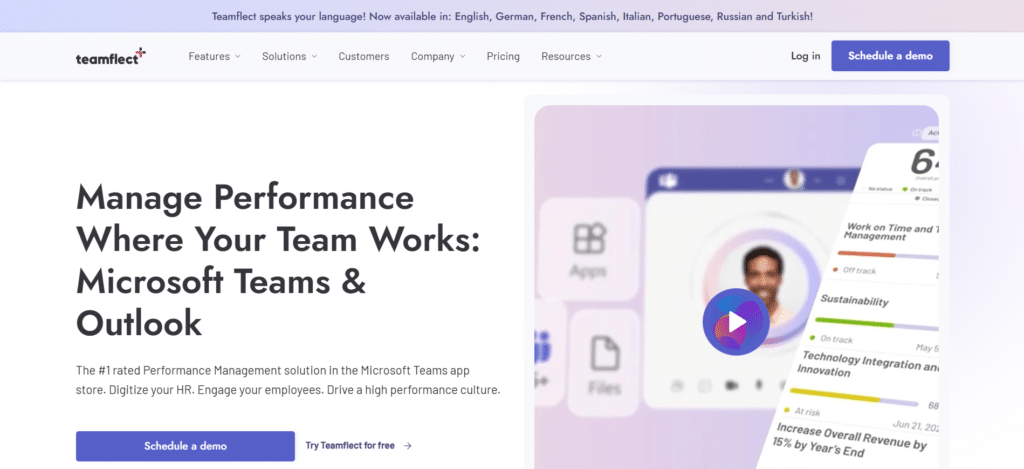
Teamflect is an all-in-one performance management and employee engagement solution built natively for Microsoft Teams and Outlook. It’s the highest-rated performance management tool in the Microsoft Teams app store, designed to keep all HR processes within the Microsoft 365 ecosystem employees already use daily.
Solutions offered by Teamflect:
- Native Microsoft 365 Integration – Run the entire performance cycle inside Teams and Outlook with single sign-on (SSO), Entra ID integration, and bi-directional sync with Microsoft To Do and Outlook Tasks.
- Performance Reviews & 360 Feedback – Build customizable review cycles with self, peer, manager, and direct report feedback. Use the extensive template library and AI-guided review writing assistance.
- Goals & OKRs – Set and track cascading goals with complete customization. Create custom goal labels, relate tasks to goals, and track progress with automated check-ins inside Teams chat.
- 1-on-1 Meetings – Structure meetings with talking points, shared and private notes, check-in forms, integrated goal setting, and task management—all within Teams meetings.
- Continuous Feedback & Recognition – Share instant feedback and celebrate achievements with customizable recognition badges and points-based rewards. Create leaderboards to foster healthy competition.
- Engagement Surveys & Pulse Checks – Run surveys directly in Teams chat with AI-powered analysis and real-time sentiment tracking.
- Teamflect Agent (AI Assistant) – Use AI to prepare 1-on-1s, generate feedback, detect burnout signals, and make smarter people decisions.
- Task Management – Create tasks from Teams chat, meetings, emails, and OKRs. Sync seamlessly with Microsoft To Do and Outlook Tasks for unified task tracking.
- Succession Planning & Career Development – Build branching career paths, create individual development plans (IDPs), and identify succession candidates.
What sets Teamflect apart:
Teamflect’s native Microsoft 365 integration means zero new logins and the highest adoption rates among competitors. Everything from goal-setting to feedback to reviews happens where employees already work—in Teams and Outlook. The platform also integrates with Power BI for advanced analytics and Power Automate for custom HR workflows.
Best for: Organizations deeply embedded in the Microsoft 365 ecosystem seeking native Teams/Outlook performance management with high adoption rates.
19. Effy.AI
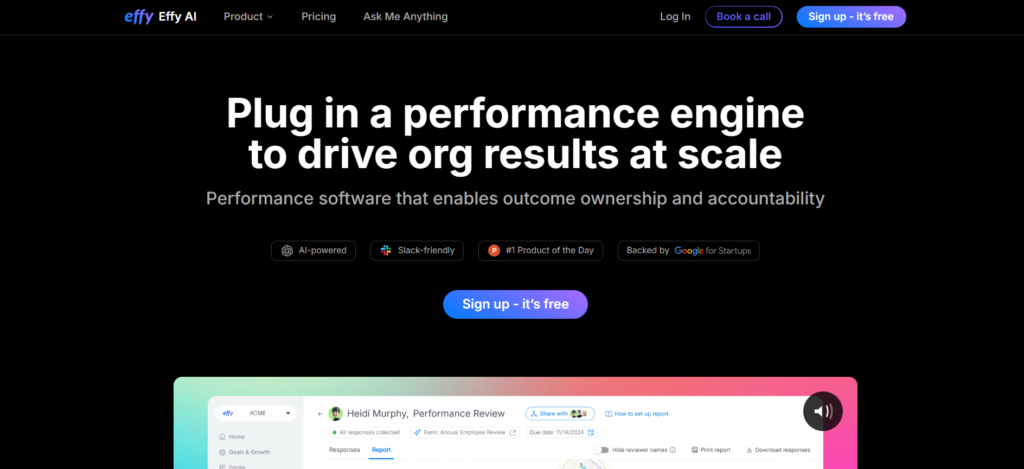
Effy.AI is an AI-first performance management platform that transforms 360-degree feedback and performance reviews from an administrative burden into strategic insights. Built for modern teams, especially SMBs, it emphasizes speed and simplicity—organizations can launch comprehensive 360 reviews in under 10 minutes.
Solutions offered by Effy.AI:
- AI-Generated Review Forms – Create tailored performance review forms within minutes using AI. The platform generates relevant questions based on role, department, and review type.
- 360-Degree Feedback – Conduct multi-source evaluations with support for self-assessments, manager reviews, peer evaluations, upward feedback, and subordinate feedback.
- AI-Summarized Results – Receive automatically generated summaries with actionable insights, highlighting strengths and areas for improvement based on collected responses.
- Slack Integration – Participants receive notifications and can submit reviews directly within Slack, enhancing accessibility and engagement without leaving their primary communication tool.
- Automated Reminders – Set deadlines and let the system send automated reminders for pending reviews, ensuring timely completion.
- Performance Analytics – Access heatmaps, 9-box grids, score trends, and bias detection to make data-driven talent decisions.
- One-on-Ones & Meeting Notes – Document regular check-ins, track discussion points, and create action items.
- Kudos & Recognition – Enable instant peer-to-peer recognition and feedback sharing.
- Goal Setting & Tracking – Set individual and team goals with progress tracking (feature expanding).
What sets Effy.AI apart:
Effy.AI’s laser focus on speed and simplicity makes it stand out. The AI-powered form creation, summarization, and bias detection mean that what typically takes hours can be done in minutes. The platform is particularly well-suited for SMBs that want enterprise-grade 360 feedback without enterprise-level complexity or cost.
Best for: Small to medium businesses and startups seeking fast, AI-powered 360 reviews with minimal setup and strong Slack integration.
20. Profit.co

Profit.co is a comprehensive OKR software platform that integrates strategy execution, performance management, task management, and employee engagement into one unified system. It’s designed to help organizations prioritize goals, execute strategies, and build high-performance cultures.
Solutions offered by Profit.co:
- OKR Management & Strategy Execution – Create, cascade, and align objectives and key results across company, department, team, and individual levels. Use AI-powered OKR templates and chatbot for instant goal creation.
- Goal Alignment & Dashboards – Visualize how individual and team goals connect to company objectives with alignment dashboards and real-time heatmaps showing OKR progress.
- Performance Reviews & 360 Feedback – Conduct customizable performance evaluations with multi-rater feedback from managers, peers, and direct reports. Link individual goals and competencies directly to reviews.
- Competency & Talent Management – Use the 9-box talent grid, competency score assessments, and skills gap analysis to identify high-potential employees and development needs.
- Automated Review Cycles – Trigger performance evaluations automatically based on custom criteria. Send personalized nudges and reminders throughout the cycle.
- Development & Succession Planning – Create automated development plans based on review results and identify succession candidates for critical roles.
- Task Management Integration – Map tasks to OKRs and key results, creating clear connections between daily work and strategic objectives.
- Check-ins & Meetings – Schedule OKR review meetings (weekly, quarterly) with automated agendas, attachments, and task boards.
- Employee Engagement – Conduct surveys, share updates via newsfeed, use hashtags for OKR engagement, and promote recognition and achievements.
- Analytics & Business Intelligence – Access PowerPoint report generation, department-specific heat maps, and company-wide performance dashboards.
What sets Profit.co apart:
Profit.co uniquely integrates OKRs, tasks, performance management, and engagement on a single platform—creating a complete performance ecosystem. The built-in strategic planning tools, reflect-reset process for quarterly OKR reviews, and extensive integration options (Jira, Slack, G Suite, Teams, 100+ more) make it particularly powerful for execution-focused organizations.
Best for: Mid-sized to large organizations focused on strategic execution through OKRs who want performance management, task tracking, and engagement unified in one platform.
Features of Top Performance Management Software
While selecting the best performance management software for the organization, it is imperative to look for some desirable features in the tool. The crux of implementing a system is to ensure performance improvisation throughout the organization and automate several manual tasks to avoid critical human errors.
Looking for the right performance management tool can be a lengthy process if the desired objectives and goals of the performance management system are not clearly defined. Conducting surveys and interviews within the firm can shed some light on the objectives.
Once the objectives are enumerated, HR managers should relate them to the below features and zero in on the tool that will meet organizational requirements. Check out the below features while selecting the best performance management platform.
Continuous Feedback Mechanism
The mechanism calls for a continuous, open, and cyclical feedback exchange between the manager and employees. It helps in finding the performance gaps of an employee and starting an improvisation plan. Through this process, managers can ensure project deliveries are not hampered and employees are getting continuous feedback on their work.
360 Degree Feedback
Also known as multi-rater feedback, it involves taking anonymous employee feedback from the colleagues he/she has a working relationship with. Managers, peers, direct reports, and subordinates all submit their feedback through a specialized mechanism.
360-degree feedback, when integrated into performance review software, provides insight into the behavior, attitude, and work relationships of employees. The unbiased nature and subjectivity of 360-degree feedback make it more acceptable to employees.
Also Read: How to effectively review employee performance?
Automated and Intuitive
A performance management solution should be user-friendly and easy to understand. The system should help in automating tasks that require regular check-ins and error-free delivery. By sending automated reminders, it can help reduce the turnaround time and delays in submissions. Business performance management software offers customizable surveys and dashboards that aid in the easy collection and visualization of employee feedback.
People Analytics
Also referred to as talent analytics or HR analytics, it is a data-driven method to study people, processes, challenges, and opportunities in the workplace. The talent insights collected through the rigorous process aid in making smarter decisions, succession planning, and improving the capabilities of the workforce.
Many organizations are heavily focused on people analytics to make HR business strategy decisions like recruitment and selection, learning and development, project management, and KPI creation and setting.
Social Performance Management
Social connection and engagement go a long way in today’s virtual business environment. In the last 2 years of the pandemic, employees working remotely have faced a lot of disconnect from their teams and organization, leading to proximity bias and reduced productivity.
Social performance management, or SPM, is a part of the software that provides a solution to stay connected within the organization by letting employees share ideas, opinions, and thoughts with everyone in the organization. Employees can ask for real-time feedback from their colleagues or managers.
Employee Reward and Recognition
(As per a survey conducted by Achievers, more than half of 1,700 respondents are actively looking out for new jobs, citing lack of recognition in the workplace). Employee reward and recognition is one key parameter that organizations need to look for in retaining potential employees.
A well-implemented reward system helps in boosting employee productivity and makes them feel valued in the workplace. Through gamification, performance management software encourages employees to reward each other for their contributions and outstanding performance.
Setting SMART Goals
A report published by Gallup highlights that over 50% of employees are not clear about what is expected from them at the workplace. Introduced in 1981 by George T Doran, SMART refers to Specific, Measurable, Achievable, Relevant, and Time-bound goals that help organizations in measuring employee performance through a defined metric.
Goal setting is one of the most critical and time-consuming processes in an organization. Yet, it has many advantages, such as providing clear expectations to the employees, reduced turnaround time, and higher productivity & engagement.
It helps in quantifying the performance of employees and offers insights to managers for plugging in performance gaps. A performance management solution aids in setting SMART goals that help in measuring employee performance in real-time.
Learning Management System
Learning is at the core of a performance management tool. It helps in assessing the current skills of an employee and charts out a defined path to develop and grow in the organization. Employees can use the module for self-assessment and set goals for themselves to hone their skills. Managers can assign certain learning modules to their employees to help them learn new skills.
Most of the employees are concerned about their skill development and career progression, so having a learning module in the system makes them feel cared for.
Customization, Security, and Integration
An important aspect of performance review software is its integration with other HR technologies and tools. As organizations these days use multiple tools for employee management, it is a fundamental requirement for software to seamlessly integrate with these tools for a better employee experience.
The various modules available in the system can also be customized as per the business needs and provide data security as per the business standards.
What Is Continuous Performance Management Software?
Continuous Performance Management (CPM) software is a modern approach to employee performance tracking that replaces rigid annual reviews with real-time feedback, agile goal-setting, and continuous coaching.
Unlike traditional models that rely on infrequent evaluations, CPM software enables frequent check-ins, dynamic goal adjustments, and data-driven decision-making to keep performance conversations ongoing.
Core Features of CPM Software:
- Goal management & alignment – Create, track, and update individual and team goals dynamically.
- Real-time feedback loops – Enable instant peer-to-peer, manager-to-employee, and 360-degree feedback.
- Performance analytics & dashboards – Use visual reports to spot trends and progress.
- Customizable review cycles – Choose weekly, monthly, quarterly, or hybrid review schedules.
- Engagement tools – Recognition badges, pulse surveys, and gamification to keep teams motivated.
Benefits for Employees & Organizations:
- For employees: Clear expectations, faster feedback, and better career growth opportunities.
- For organizations: Higher retention, more agility, and stronger alignment between strategy and execution.
Why CPM Software Matters in 2026
Workplaces in 2026 demand agility. The shift to hybrid and remote work has made real-time performance conversations essential.
Trends driving CPM adoption:
- Agile performance models – Organizations are replacing rigid cycles with flexible, on-demand reviews.
- Data-driven decision making – Managers now rely on analytics for talent planning.
- Real-time coaching & recognition – AI-powered tools like Workhuman’s Human Intelligence recommend timely recognition and corrective feedback.
- Employee expectations for feedback – Millennials and Gen Z prefer weekly or monthly check-ins over annual reviews.
- Integration with everyday tools – CPM is now built into Slack, Teams, and HRIS platforms for seamless use.
Concluding Words
Performance management software is the key to building a skilled, motivated, engaged, and performance-driven workforce. In the highly competitive and rapidly changing business environment, the success of an organization lies in how well it is managing its employees.
By shifting from traditional tools to modern tech-loaded systems, organizations can bring a real impact on their business. We hope the information shared in this article will help you in selecting the best performance evaluation software.

